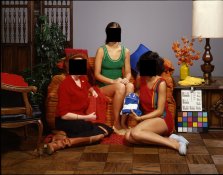Ok, so scanning my E6 films is a waste of time because its digital?
It appears that digital printing is the only way to print my E6 now, so i dont know what you are getting at?
Im trying to come up with a way to optically print E6 onto RA4, and projecting it digitally as an inverted image would do just this.
(...)
The lab I contacted can print from a digital file, which is great as i dont have to send my filmstrips overseas for printing.
They say they can print from a digital interpositive.
The current state of the art in scanning can retrieve about 4000 dots per inch which is discarding quite a bit of information relative to what is really present on the film. Also, the resolution of the scanner being way less than the object to be scanned (film grains) means sometimes the horrible problem of
grain aliasing will appear, where the resulting scanned image has an exxagerated amount of grain, grain which also does not have the character of actual film grain, being just an artifact of the process. This is especially evident when scanning ISO 400 (or faster) B&W film.
It was notorious, for example, when i had some pictures made on Superia 1600, which printed just fine optically on 8x11" paper with pretty acceptable (and beautiful) grain. When i tried to do exactly the same print digitally (by scanning and then exposing RA4 paper), the grain was just horrible, unacceptably big. Quite a difference.
You can search for Henning Serger's posts on the actual resolution of state-of-the-art films shot perfectly, compared to what a scanner can bring.
Of course, for small enlargements the digital system works just fine, but photographers who wish to sell their work (or hang their pictures nicely on the wall) deserve and demand better.
Moreover, the process of printing using an enlarger is (arguably) faster; high-resolution scanning of a negative can take quite a bit of time, 20 minutes for example.
Now back to Ferrani
a(with an A at the end and only one N...)
As far as we know, they have a film coater, not paper coater. So if there is any chance of a Reversal paper, it would have then to be coated by other company.
What I say is: Let the new Ferraniacolor reversal ISO 100 film enter the market, let Dave & friends market it effectively (
a la Ilford, not
a la Alaris), and should the use of E6 increase over the next two years, the reversal paper should appear as a consequence -- be it from Inoviscoat, for example.







